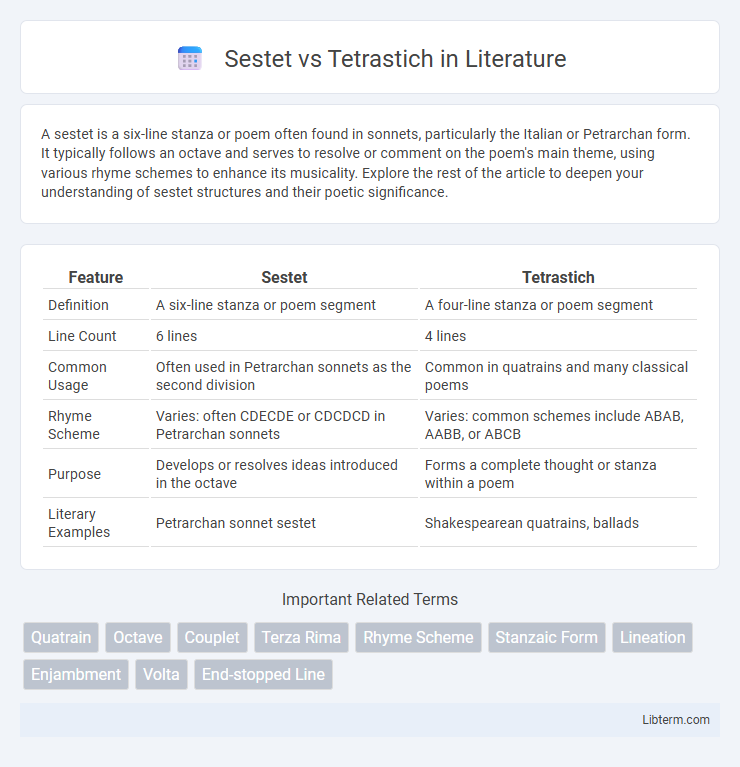A sestet is a six-line stanza or poem often found in sonnets, particularly the Italian or Petrarchan form. It typically follows an octave and serves to resolve or comment on the poem's main theme, using various rhyme schemes to enhance its musicality. Explore the rest of the article to deepen your understanding of sestet structures and their poetic significance.
Table of Comparison
| Feature | Sestet | Tetrastich |
|---|---|---|
| Definition | A six-line stanza or poem segment | A four-line stanza or poem segment |
| Line Count | 6 lines | 4 lines |
| Common Usage | Often used in Petrarchan sonnets as the second division | Common in quatrains and many classical poems |
| Rhyme Scheme | Varies: often CDECDE or CDCDCD in Petrarchan sonnets | Varies: common schemes include ABAB, AABB, or ABCB |
| Purpose | Develops or resolves ideas introduced in the octave | Forms a complete thought or stanza within a poem |
| Literary Examples | Petrarchan sonnet sestet | Shakespearean quatrains, ballads |
Understanding Sestet and Tetrastich
A sestet is a six-line stanza often found in sonnets, particularly the Italian (Petrarchan) form, where it follows an octave and provides resolution or commentary. A tetrastich consists of four lines and can stand alone as a quatrain or form part of a longer poem, commonly used in various poetic forms for rhythmic balance and thematic development. Understanding the distinct line counts and structural roles of sestet and tetrastich enhances appreciation of poetic form and its impact on meaning and flow.
The Structure of a Sestet
A sestet is a six-line stanza or poem segment often found in sonnets, particularly Petrarchan sonnets, characterized by varied rhyme schemes such as CDECDE or CDCDCD. Its structure typically serves as a response or resolution to the octave's problem or question, providing thematic contrast or closure. In contrast, a tetrastich consists of four lines with simpler rhyme patterns and is commonly used in quatrains, emphasizing brevity and concentrated expression.
Defining the Tetrastich
A tetrastich is a stanza or poem consisting of four lines, often used in classical and contemporary poetry to create concise, impactful verses. Unlike a sestet, which contains six lines and is commonly found in the concluding sestets of Petrarchan sonnets, tetrastichs allow for balanced, rhythmic expression within a shorter structure. The tetrastich's four-line form supports varied rhyme schemes and meters, making it a versatile and foundational poetic unit.
Historical Origins of Sestet and Tetrastich
The sestet and tetrastich are poetic forms with distinct historical origins rooted in classical literature. The sestet, traditionally a six-line stanza, evolved prominently in Italian Renaissance poetry, especially within Petrarchan sonnets, where it served as the poem's resolution following the octave. The tetrastich, a four-line stanza, traces back to ancient Greek and Latin poetry, commonly appearing in elegiac couplets and early European folk ballads, establishing a foundational structural unit for quatrains in diverse poetic traditions.
Key Differences Between Sestet and Tetrastich
A sestet consists of six lines forming a poetic stanza, commonly found in sonnets and Italian poetry, whereas a tetrastich comprises four lines and appears frequently in quatrains or certain lyric poems. The rhythmic and rhyme schemes differ, with sestets often featuring complex patterns like CDE CDE, while tetrastichs typically use simpler schemes such as ABAB or AABB. Structurally, sestets provide extended thematic development compared to the more concise and focused expression found in tetrastichs.
Poetic Functions of Each Form
Sestets, consisting of six lines, often serve to resolve or contrast ideas established in preceding stanzas, enhancing the poem's thematic depth and emotional impact through their structural closure. Tetrastichs, four-line stanzas, typically function to establish rhythm and concise expression, enabling poets to present vivid imagery or succinct arguments with clarity and focus. The choice between sestet and tetrastich influences the pacing and emphasis in poetry, allowing varied exploration of mood, tone, and development of poetic themes.
Famous Examples of Sestet in Poetry
Sestet, a six-line stanza or poem segment, often concludes the Italian sonnet, providing resolution or counterpoint to the octave's problem. Famous examples of sestets appear in Petrarch's sonnets, where the sestet typically follows an ABBAAB rhyme scheme, delivering emotional profundity and thematic closure. Contrarily, a tetrastich consists of four lines and is prevalent in various poetic forms, focusing on concise thematic expression.
Notable Tetrastich Poems and Poets
Tetrastich, a quatrain consisting of four lines, appears prominently in classic literature with notable poems like Robert Frost's "Stopping by Woods on a Snowy Evening" and William Blake's "The Tyger." Esteemed poets such as Emily Dickinson and Langston Hughes extensively used tetrastich structures to convey vivid imagery and profound themes. Compared to sestets, tetrastich offers greater flexibility and rhythmic diversity, making it a favored form in both traditional and contemporary poetry.
When to Use Sestet vs Tetrastich
Use a sestet when structuring a sonnet or a poem that requires a six-line stanza, especially to provide resolution or contrast following an octave. Opt for a tetrastich when aiming for compact expression or rhythmic consistency within four-line stanzas, commonly found in quatrains or ballads. Choosing between sestet and tetrastich depends on the desired poetic form, thematic development, and the meter pattern intended by the poet.
Crafting Impactful Verses: Tips for Poets
Sestet and tetrastich are distinct poetic structures that shape the rhythm and emotional resonance of a poem, with sestet consisting of six lines often used to resolve a sonnet's volta, while tetrastich comprises four lines, commonly employed in quatrains to build thematic unity. Poets crafting impactful verses should focus on precise word choice and meter alignment within these forms to maintain harmonic flow and engage readers effectively. Mastery of sestet's concluding depth and tetrastich's concise expressiveness enhances a poem's narrative strength and emotional clarity.
Sestet Infographic

 libterm.com
libterm.com